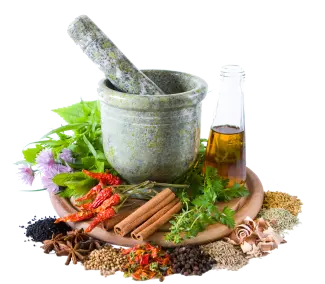Introduction
Pneumonia is a respiratory infection that inflames the air sacs in the lungs, causing them to fill with fluid or pus, leading to symptoms like cough, difficulty breathing, and fever. While conventional medical treatments play a crucial role in managing pneumonia, Ayurveda, an ancient system of medicine originating in India, offers holistic approaches that focus on restoring the balance between the body, mind, and spirit to promote natural healing. This article explores the AyurvedGuru perspective on pneumonia and the potential treatments it offers.
Understanding
In AyurvedGuru, pneumonia can be understood through the lens of "Pranavaha Srotas," the channel responsible for respiratory function. An imbalance in the doshas (Vata, Pitta, and Kapha) can disrupt this channel and lead to respiratory disorders, including pneumonia. Imbalances can be caused by poor digestion, weakened immune system, improper lifestyle, and environmental factors.
Causes
Bacterial Infections:
Bacterial pneumonia is often caused by Streptococcus pneumoniae (pneumococcus). Other bacteria, such as Haemophilus influenzae, Mycoplasma pneumoniae, and Legionella pneumophila, can also lead to pneumonia.
Viral Infections:
Viruses, including the influenza virus (the flu), respiratory syncytial virus (RSV), rhinoviruses, and adenoviruses, can cause viral pneumonia. COVID-19, caused by the SARS-CoV-2 virus, is another viral respiratory infection that can lead to pneumonia.
Fungal Infections:
Fungal pneumonia is less common and typically affects individuals with weakened immune systems. It can be caused by fungi such as Pneumocystis jirovecii or Histoplasma capsulatum.
Aspiration:
Aspiration pneumonia occurs when foreign substances, such as food, liquids, or vomit, are inhaled into the lungs, leading to infection and inflammation.
Chemical Irritation:
Inhalation of toxic chemicals, fumes, or irritants can damage the lung tissue and lead to chemical pneumonia.
Hospital-Acquired (Nosocomial) Pneumonia:
Some individuals develop pneumonia while in the hospital, often due to the presence of drug-resistant bacteria or exposure to healthcare-associated pathogens.
Community-Acquired Pneumonia (CAP):
CAP refers to pneumonia acquired outside of healthcare settings and can be caused by various pathogens, including bacteria and viruses.
Symptoms
Cough:
A persistent cough that may produce mucus (sputum) that can be yellow, green, or rust-colored.
Fever:
A high fever is a common symptom of pneumonia, especially in bacterial or viral cases.
Chills:
Feeling chilled and shivering due to fever.
Shortness of Breath:
Rapid or shallow breathing, along with difficulty breathing deeply.
Chest Pain:
Chest discomfort or pain that may worsen with deep breaths or coughing.
Fatigue:
Feeling extremely tired or weak.
Loss of Appetite:
Reduced appetite and decreased food intake.
Confusion (in older adults):
Pneumonia can cause confusion or changes in mental awareness, especially in older individuals.
Nausea and Vomiting:
Some people with pneumonia may experience nausea and vomiting.
Headache:
Headaches can occur, particularly with viral pneumonia.
Muscle Aches:
Generalized muscle aches and pain.
Blue Lips or Nails:
In severe cases, pneumonia can lead to a bluish discoloration of the lips or nails due to a lack of oxygen in the blood.
Ayurvedic Treatment
Herbal Remedies:
Tulsi (Holy Basil): Known for its antimicrobial properties, tulsi can help reduce inflammation, clear respiratory passages, and enhance immunity. Yashtimadhu (Licorice): This herb has soothing properties that can help relieve cough and irritation in the throat.
Sitopaladi Churna: A traditional Ayurvedic formulation containing herbs like cardamom and cinnamon, which can help manage respiratory infections.
Nasya (Nasal Application): Administering medicated oils or herbal preparations through the nasal passages can help clear congestion and enhance respiratory function.
Steam Inhalation:
Inhaling steam infused with herbs like eucalyptus, mint, or camphor can provide relief from congestion and ease breathing difficulties.
Panchakarma Therapies:
These are specialized AyurvedGuru detoxification therapies that can help remove toxins and balance the doshas. Vamana (therapeutic vomiting) and Virechana (therapeutic purgation) are specific Panchakarma procedures that might be considered for respiratory disorders.
Lifestyle Modifications:
Ayurveda emphasizes maintaining a balanced daily routine, including proper sleep, regular exercise (as per individual capacity), and stress reduction through practices like yoga and meditation.
Personalized Approach:
Ayurveda treats individuals based on their unique constitution (Prakriti) and imbalances (Vikriti). Consulting an experienced AyurvedGuru practitioner can help determine the appropriate treatments for the individual.
Caution and Collaboration
While AyurvedGuru treatments offer potential benefits for pneumonia, it's important to note that severe cases of pneumonia often require conventional medical interventions, such as antibiotics and hospitalization. AyurvedGuru approaches can be used as complementary support alongside conventional treatments, but consultation with a healthcare professional is essential, especially in serious or acute cases.
AyurvedGuru provides a holistic approach to managing pneumonia by addressing the underlying imbalances in the body and promoting overall well-being. Through dietary adjustments, herbal remedies, therapeutic practices, and personalized approaches, Ayurveda aims to support the body's innate healing capabilities. However, a collaborative approach that combines AyurvedGuru wisdom with modern medical knowledge is crucial for effectively managing pneumonia and ensuring the best possible outcomes for patients.



.webp)




